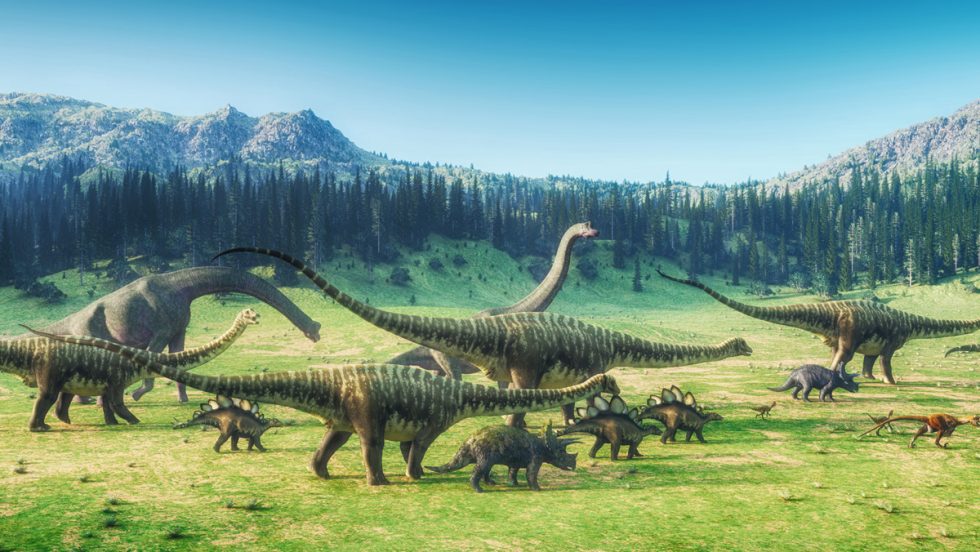
You won't find the dinosaur known as Xixianykus terrorizing people in Jurassic Park.
The species, which lived more than 80 million years ago, is estimated by scientists to have been about the size of a cat, covered with feathers and to have dined on ants and termites. Nonetheless, it was part of the theropod family of meat-eating dinosaurs that ranged in size from the bus-sized T. rex, to the dog-sized Velociraptor, to the birds we know today.
Why did theropods vary so much in size? Adelphi University’s Michael D’Emic, PhD, associate professor of biology, is the lead author of a new study published in the journal Science that answers this question, which has eluded scientists for years. His research also has implications on how environmental or other factors affect the growth patterns of other species—past and present.
A Window Back in Time
“Most animals are thought to evolve to be larger or smaller by growing faster or slower than their ancestors, but this study shows that it’s just as likely that bigger or smaller animals grew for longer or shorter periods of time during growth spurts,” said Dr. D’Emic.
The bones of many animals, including dinosaurs, slow or pause growth every year, leaving marks like tree rings that indicate the animal’s age and growth rate. “Widely spaced rings indicate faster growth and narrowly spaced rings tell us that an animal was growing more slowly,” he explained.
Dr. D’Emic and a team of international researchers measured about 500 such growth rings in about 80 different theropod bones. “We found that there was no relationship between growth rate and size,” said Dr. D’Emic. “Some gigantic dinosaurs grew very slowly, slower than alligators do today. And some smaller dinosaurs grew very fast, as fast as mammals that are alive today.”
Dr. D’Emic was interviewed about his work on NPR on February 26. He also maintains a website that offers a more in-depth look at his research, including his most recent study, and features the students who get to partner and work with him.
Students Dig Into Dinosaur Research
Students from Adelphi as well as other institutions get to work alongside Dr. D’Emic. Thomas Pascucci, MS ’19, adjunct faculty member at Adelphi, contributed to this latest project as a co-author. He said the findings made sense to him: “Extinct animals like dinosaurs inspire awe because of how different they seem from those in our modern world, but they were animals that grew under constraints and environmental factors similar to those that exist today.”
The research team found that it was just as common for meat-eating dinosaurs to evolve changes to how fast they grew as it was to evolve changes to how long they grew.
“This has really important implications because changes in rate versus timing can correlate to many other things, like how many or how large your offspring are, how long you live or how susceptible to predators you are,” Dr. D’Emic said. “Hopefully this research spurs investigations into other groups, both alive and extinct, to see what developmental mechanisms are most important in other types of animals.”
Riley Sombathy, MS ‘21, co-author and Ohio University graduate student hopes to take up some of those investigations, adding, “One of the things that interests me about the results of our project is the apparent decoupling between growth rate and body size.”
This study opens the door to future investigations of how animals regulate their growth. According to study co-author and professor at Ohio University Patrick O’Connor, PhD, “Alteration of different growth control mechanisms, at molecular or genetic levels, probably account for the range of developmental strategies our team observed in theropod dinosaurs. Future studies of living organisms provide an opportunity to elucidate mechanisms related to the evolution of body size in vertebrates more generally.”
The paper, “Developmental strategies underlying gigantism and miniaturization in non-avialan theropod dinosaurs,” was also co-authored by Patrick O’Connor, PhD, and Riley Sombathy of Ohio University; Ignacio Cerda of Consejo Nacional de Investigaciones Científicas y Técnicas (CONICET) and Universidad Nacional de Río Negro in Argentina; David Varricchio, PhD, of Montana State University; Diego Pol, PhD, of CONICET-Museo Paleontológico Egidio Feruglio in Argentina; Rodolfo Coria of Museo Carmen Funes in Argentina; and Kristina A. Curry Rogers, PhD, of Macalester College in Minnesota.